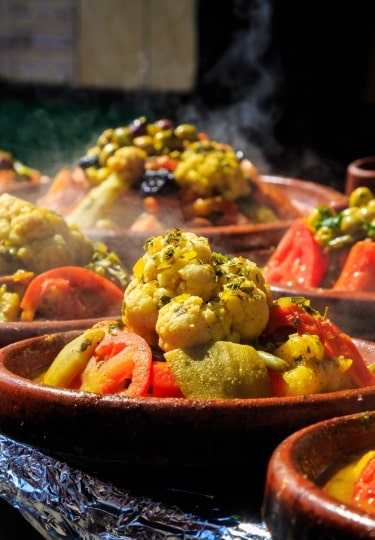Moroccan food is a rich blend of flavors and traditions, including Arabic, Andalusian, and Mediterranean influences. At its heart is a blend of spices, called ras el hanout, dominated by cumin, coriander, turmeric, cinnamon, and saffron.
Ras el hanout means “head of the shop”, meaning the best on offer in the bazaar. Every cook has their own mix, often handed down through generations, with some said to involve up to 100 ingredients.
The art is in balancing the flavors, without overwhelming any ingredient. That’s a philosophy that extends to the communal meals that are a symbol of Morocco’s hospitality and warm social tolerance.
Tajine
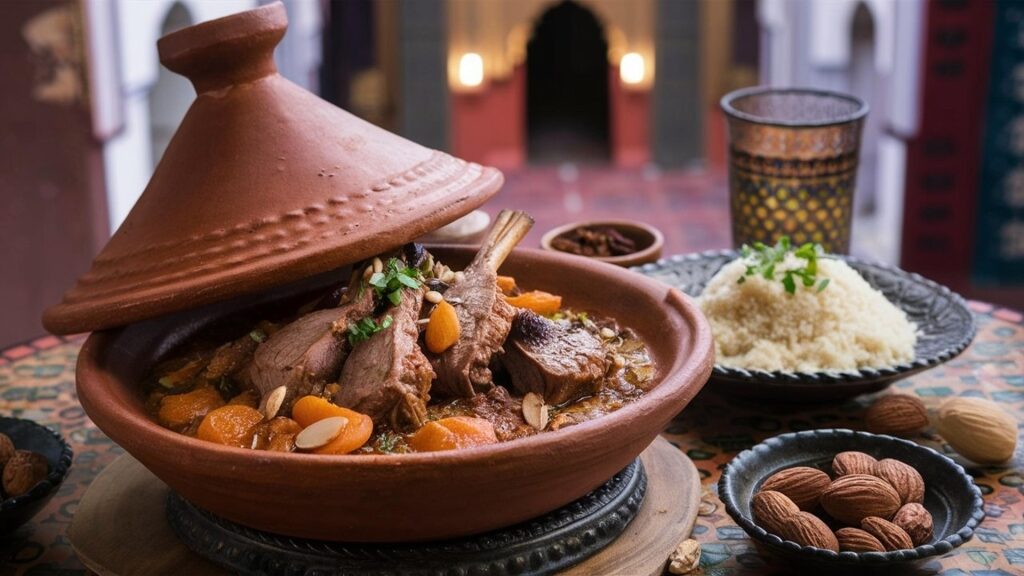
Tajine
Morocco is known for tagine, the quintessential dish named after the conical earthenware pot in which it is cooked. The conical lid of a tajine/tagine allows steam from cooking to condense and fall back into the food.
This self-basting process produces really tender meat and vegetables, the flavors of which are infused together with the typical Moroccan spice mix. Common combinations include lamb with prunes or chicken with lemon and olives.
A distinctive feature of tajines is the contrast of preserved fruit, such as lemon or prunes, with the meat and vegetables. The tajine is brought to the table, where the dish is eaten with bread to soak up the flavourful sauce.
Couscous
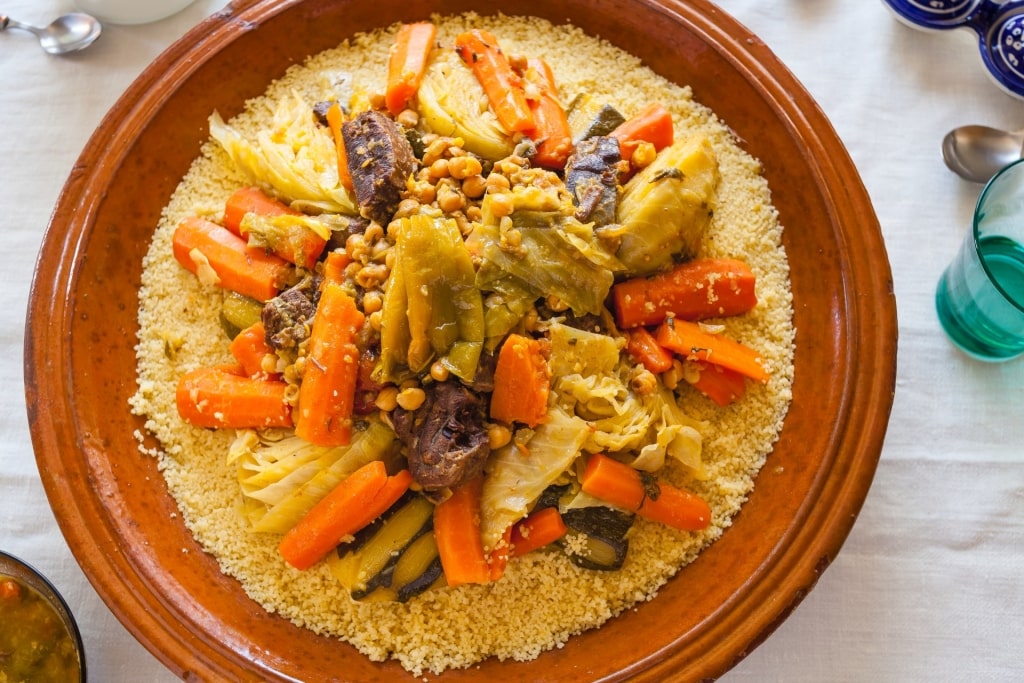
Couscous
If you’re looking for Morocco’s national food, couscous might well be it. Its base is hand-rolled grains of semolina, steamed over a rich broth and kept fluffy by constant stirring.
The light, airy couscous is then served with toppings of cooked vegetables and tender meats such as lamb or chicken. The broth is put out separately to add according to personal taste.
It’s traditional to have couscous as a family meal after visiting the mosque on Friday afternoons, eating it by hand or with a spoon.
Pastilla/Bastilla
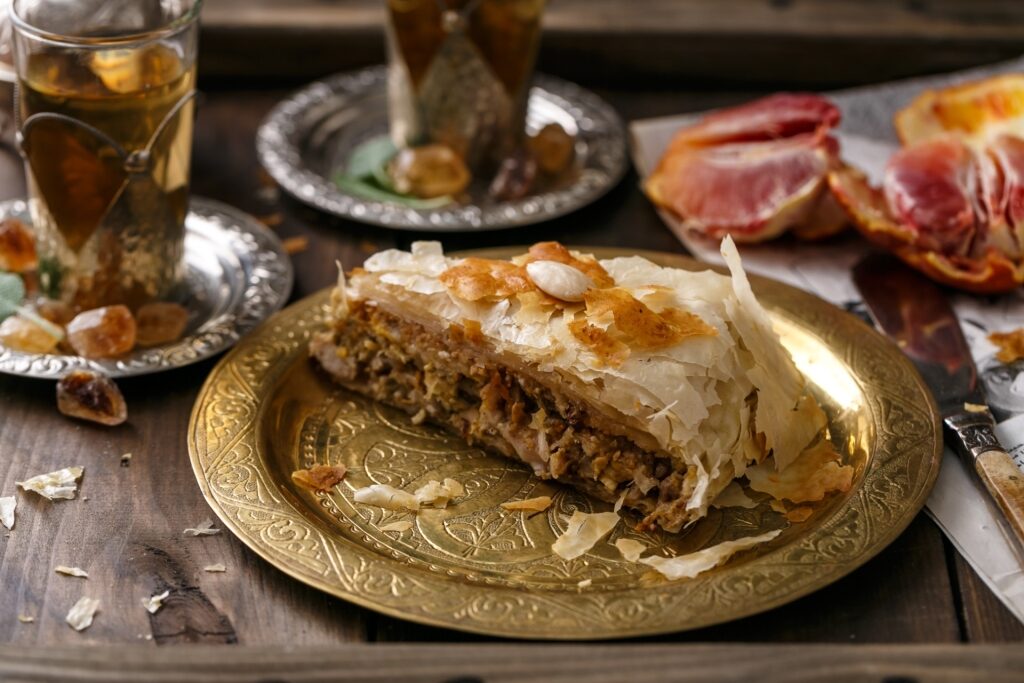
Bastilla
Once made with pigeon but now usually chicken, pastilla—or bastilla—is a savory-sweet filled pastry treat. The meat, combined with almond, egg, and spices, is cooked in warka, a phyllo-like layered wrapping.
The finished pastry is dusted with powdered sugar and cinnamon. Biting through the crisp, sweet shell, you hit the tender, spicy meat in a sensational mix of tastes and textures.
The dish has its roots in Andalusian cuisine, brought by Moors fleeing Spain in the 15th century. Taking great skill to do well, modern variations include seafood or vegetarian fillings.
Harissa
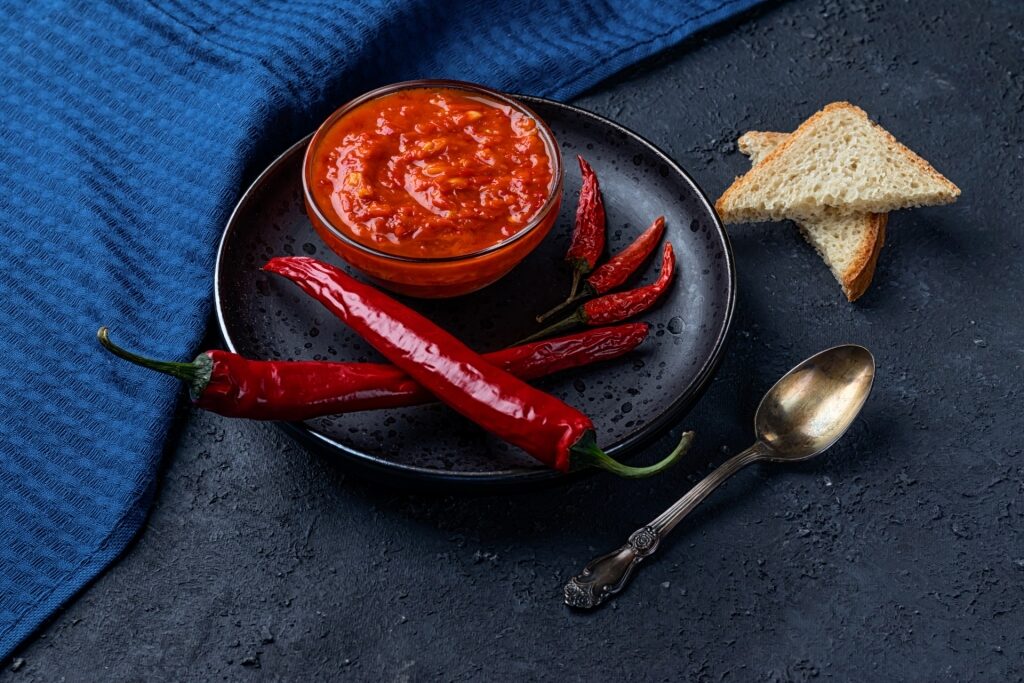
Harissa
Harissa is a red, chili-hot paste, one Algeria claims as its own, but Morocco has its own, milder regional versions. It’s made from a mix of roasted red peppers, chili pepper, herbs, and various spices, such as cumin and coriander.
These are all mixed with olive oil to create a distinctive, red paste that is a common seasoning for many dishes. It has a complex balance of heat, earthiness, and fragrance that can become addictive.
Every region of Morocco has its own variations, including ones that add ingredients such as preserved lemon. A preference for less heat and more depth reflects the subtleties of Moroccan cuisine.
Harira
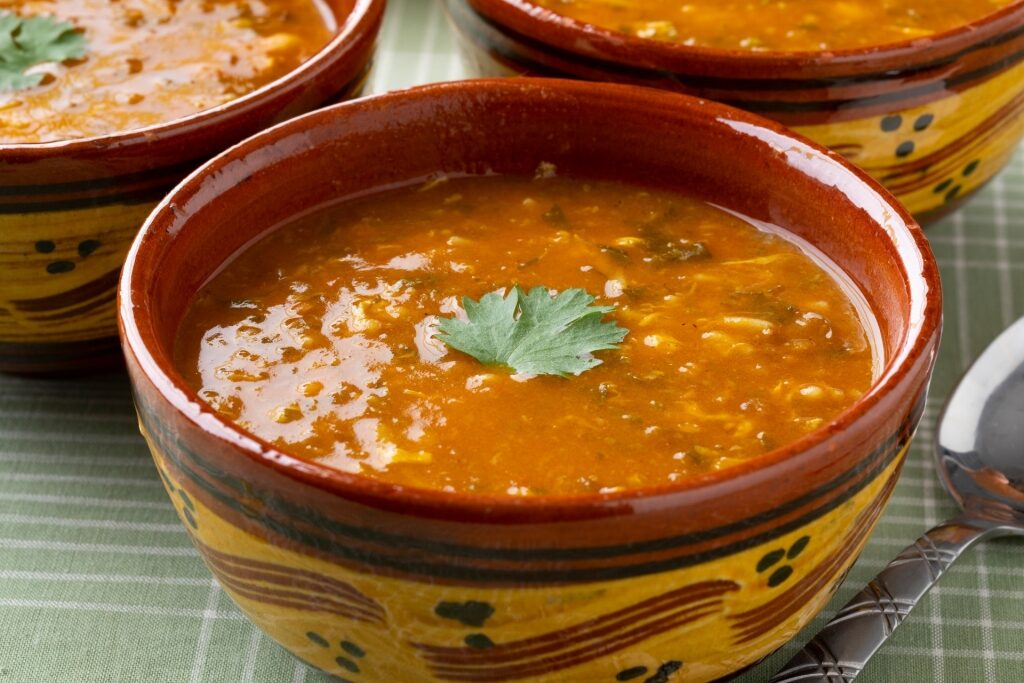
Harira
Harira is a traditional Moroccan soup, a staple for breaking the Ramadan fast but enjoyed year-round. It’s a hearty mix of lentils, chickpeas, and often lamb, with broken spaghetti, onion, celery, and a tomato base.
The soup is thickened with flour and egg, giving it a distinct mouth feel. Its flavor is enhanced by spices such as turmeric, cinnamon, ginger, and pepper.
The addition of fresh cilantro, and parsley—and a dash of lemon—is also key to harira’s appeal. It’s served with dates and chebakia, honey-coated sesame cookies, or hard-boiled eggs.
Khobz
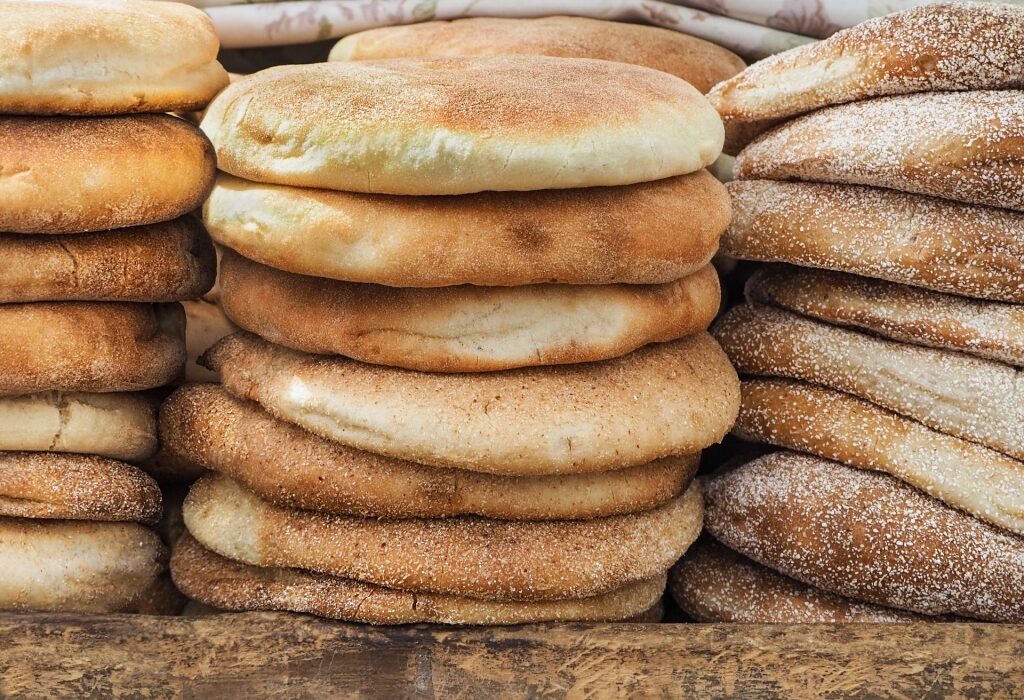
Khobz
A warm loaf of khobz bread is an essential at every Moroccan meal. Flat and round, it has a distinctive crusty top traditionally patterned with a fork.
Khobz has to be soft enough to tear into chunks, yet firm enough to use in scooping up food, especially juices. It’s a real skill to get it right from a simple recipe of flour, yeast, salt, and water.
Semolina is added to help give some of that necessary texture. Anise or cumin seeds may also be added, among several regional variations.
Read: Best Things to Do in Morocco
Msemmen
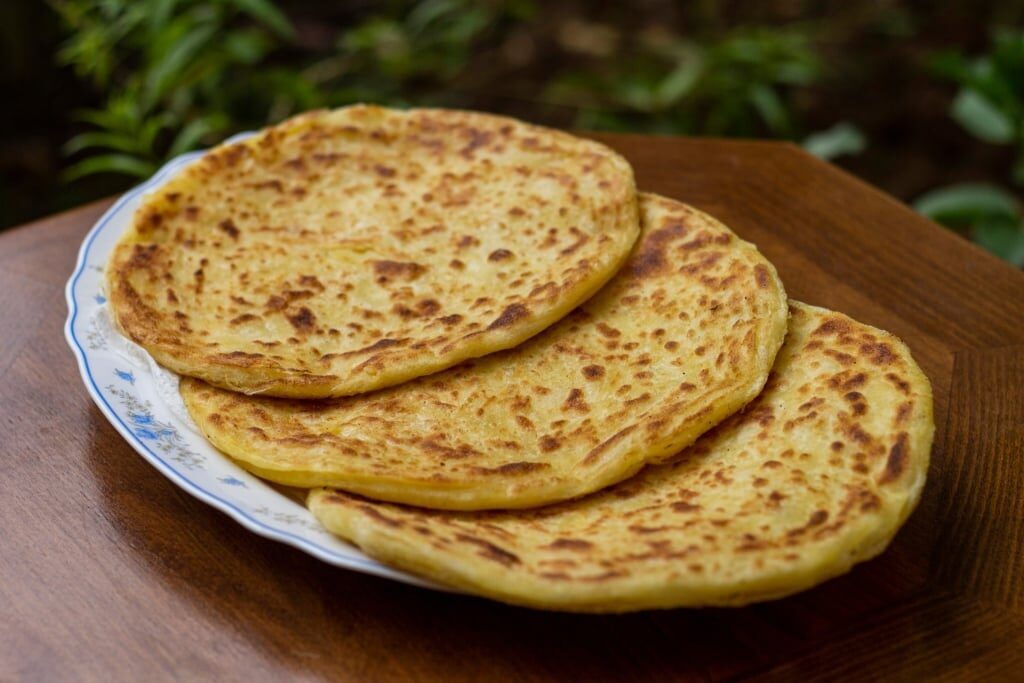
Msemmen
Another traditional flatbread, msemmen differs from Khobz in having a multi-folded dough, like puff pastry. The Moroccan equivalent of a pancake, it’s as light and delicious as it sounds.
The basic dough is similar to khobz but is folded into layers with butter or oil between each. Rolled thin, it’s cooked on a hot griddle until crispy on the outside.
Among the popular street foods in Morocco, many vendors will make it fresh in an appetizing display of skill. It’s eaten for breakfast or as a snack with mint tea and comes with a choice of fillings or toppings from ground beef to honey.
Rfissa
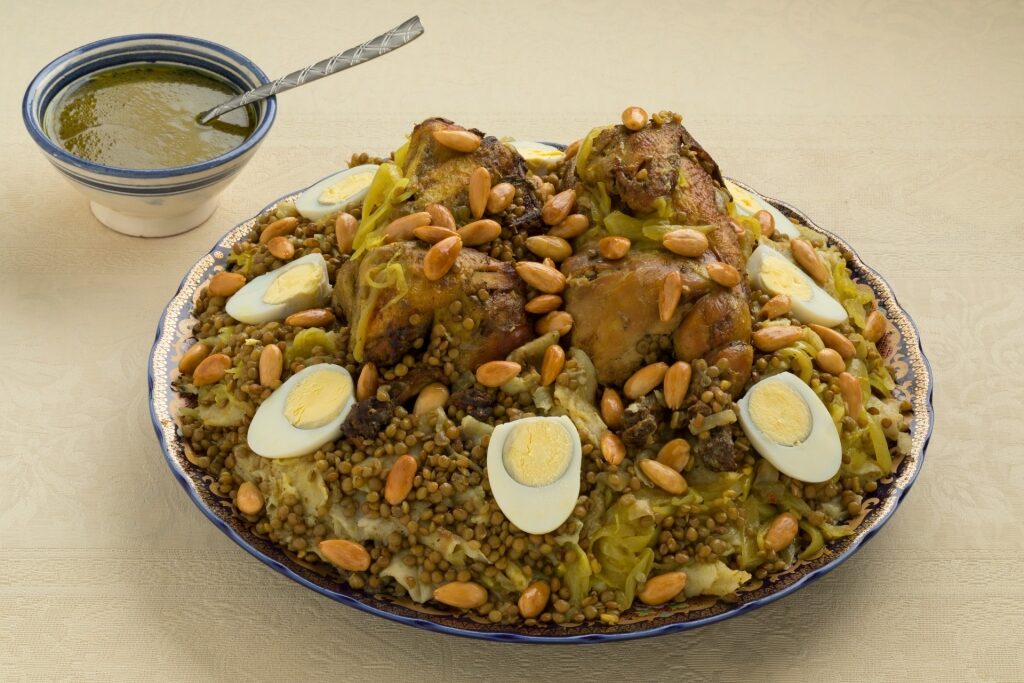
Rfissa
This traditional dish combines shredded msemmen—layered flatbread—or day-old bread with a rich lentil and chicken stew. It’s seasoned with a blend of spices that includes ginger, pepper, turmeric, and fenugreek.
Time-intensive to prepare, rfissa is a special occasion food in Morocco. It is often given to new mothers, as the fenugreek is believed to give strength and boost milk production.
The slow-cooked chicken and lentil broth, soaked up by the layered bread, gives a satisfying mix of textures. The fenugreek helps thicken the dish while adding its distinctive bitter-sweet flavor.
Bissara
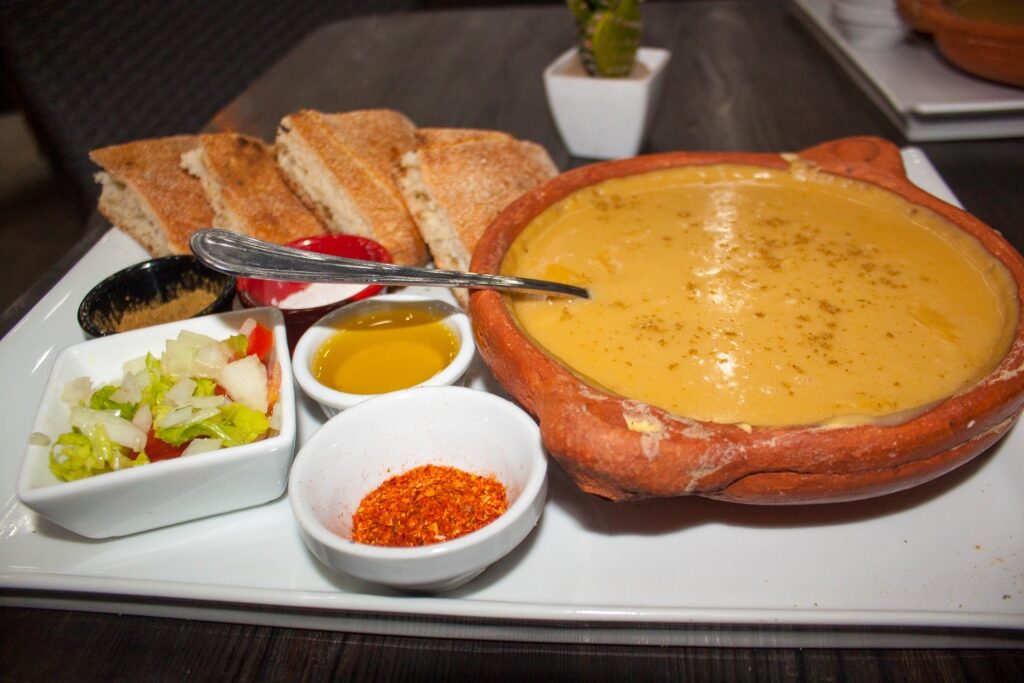
Bissara
Bessara is a hearty soup with a base of dried fava beans or split peas, simmered to a smooth, thick consistency. It’s flavored with garlic, olive oil, cumin, and paprika.
Like any soup, long, slow cooking is essential for the best flavor. The dish is particularly popular in northern Morocco and during the winter months.
Comfort food at its best, bissara is often eaten at breakfast with fresh bread. You’ll find street vendors selling it in the morning hours.
Loubia
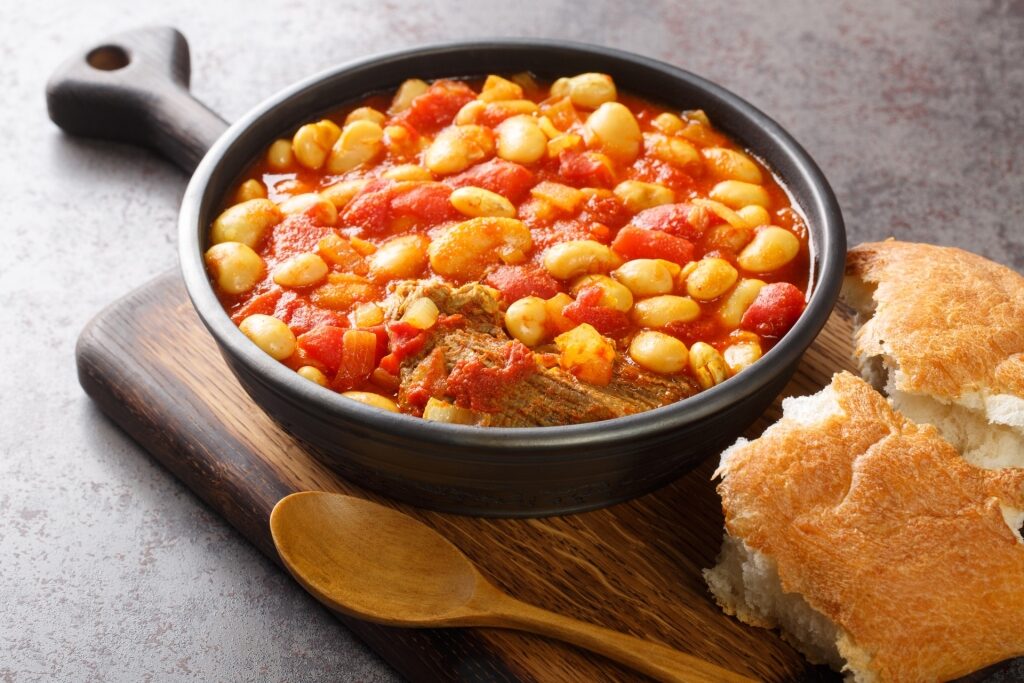
Loubia
Stewed white beans might sound very bland, but the addition of Moroccan spices lifts it to another level. Comfort food at its most basic, loubia is eaten with bread at any time of the day.
The beans are soaked overnight, then slowly cooked with fresh tomatoes, ginger, paprika, and cumin. Garlic and fresh herbs—and even a dash of chili—add even more depth of flavor.
While loubia is a vegetarian dish, it might also have some meat or meat stock added. It’s eaten with a spoon, or by using crusty khobz bread as a scoop.
Zaalouk
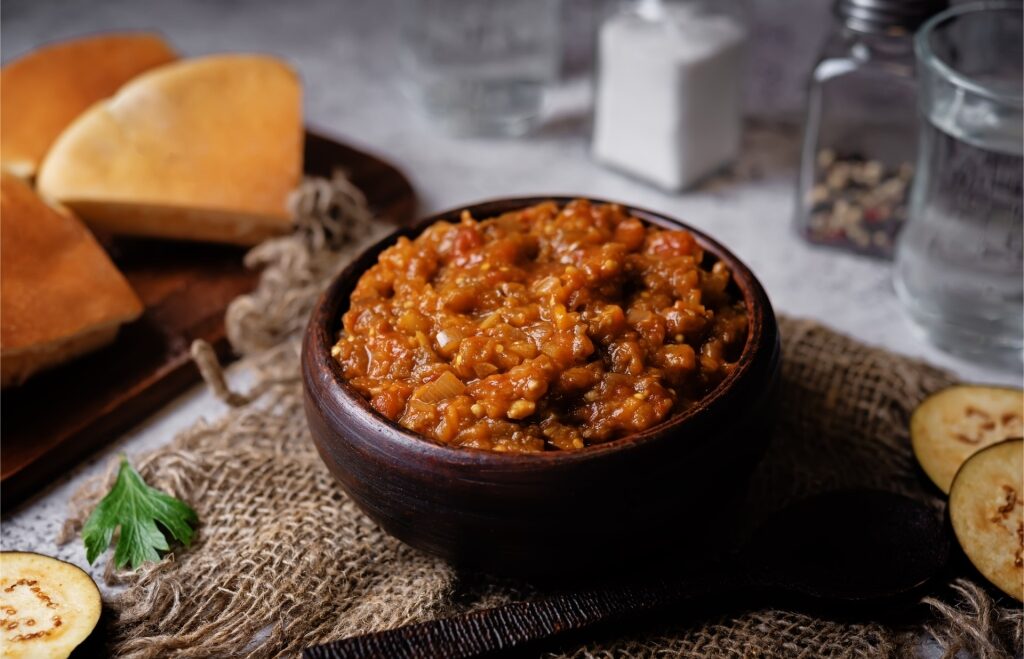
Zaalouk
Zaalouk is a staple of Moroccan cuisine, based on roasted or grilled eggplant. Cooked until soft and smoky, the eggplant is mashed with cooked tomato.
Flavored with garlic, cumin, and paprika, the dish is then cooked slowly with olive oil while it thickens. Zaalouk can be served hot or cold, usually as part of a mezze platter.
Typically eaten as a dip with fresh bread, this vegetable dish is both healthy and delicious. The mix of smoky eggplant, rich tomato, and spices creates a rich, complex taste.
Mechoui
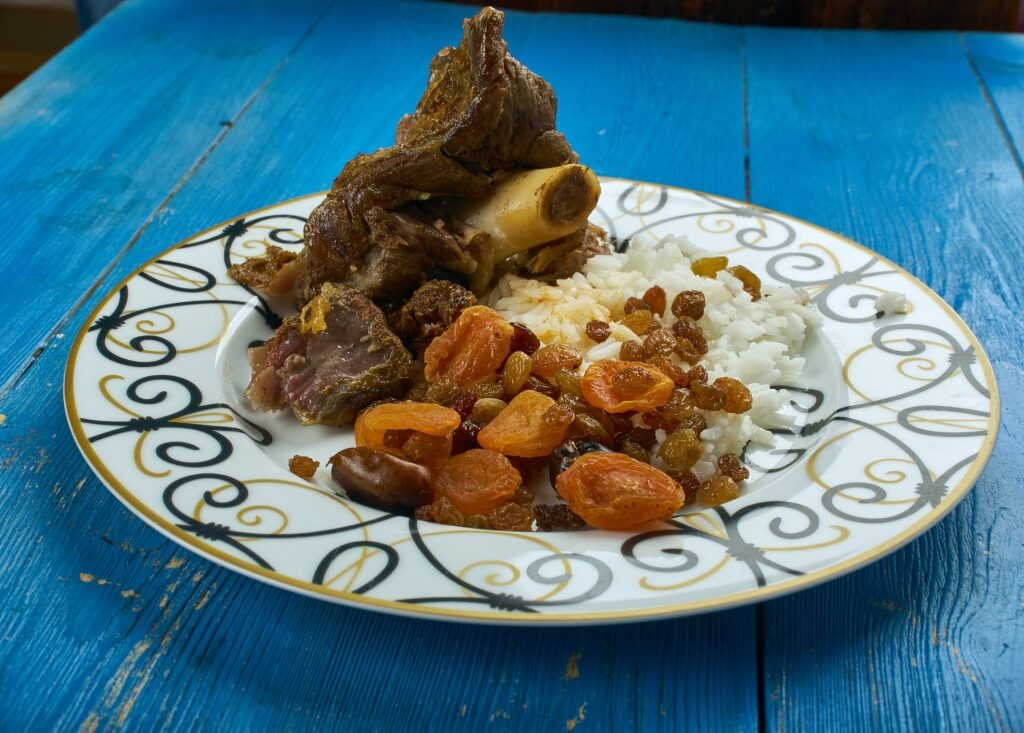
Mechoui
A meal for celebrations and festivals, mechoui is a whole roasted lamb. It’s eaten communally, with the tender meat being torn off using portions of flatbread.
The lamb is marinated in a mix of cumin, paprika, black pepper, and other spices, often with saffron as well. It’s then cooked for hours on a spit or in an oven until the meat falls off the bone.
Ideally, the skin is still crisp but not burnt, so careful cooking is needed. Typical seasoning is salt and cumin, available to diners to add to individual taste.
Tangia
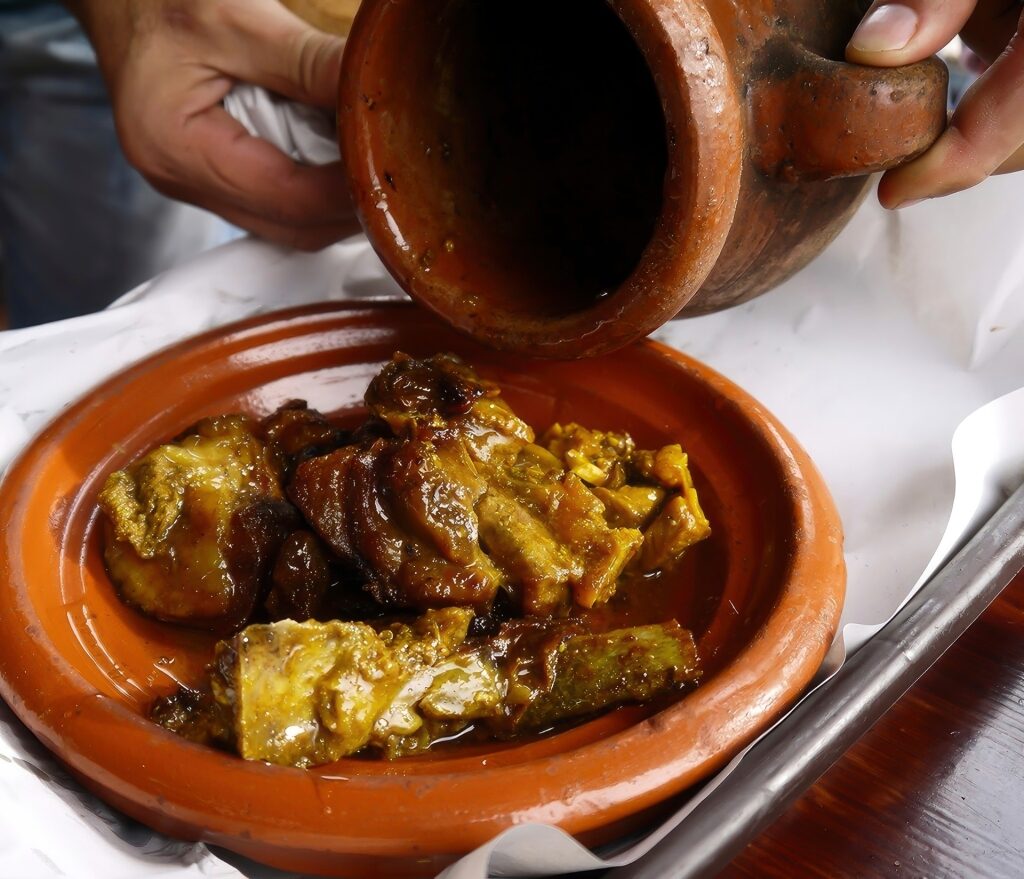
Tangia
Another dish named after the urn-shaped pot it is cooked in, tangia is simpler than tajine. Often called a “bachelor’s meal”, it’s usually just meat, normally lamb, and preserved lemon.
Traditionally, the pot was prepared in the morning and left at the local hammam. It was then cooked in the fire that heated the bathhouse water.
This slow cooking method blends the rich spice seasoning with the juices of the tenderized meat and contrasting fruit. The resulting dish—comfort food at its finest—is eaten straight from the pot with fresh bread.
Sardines Mchermel
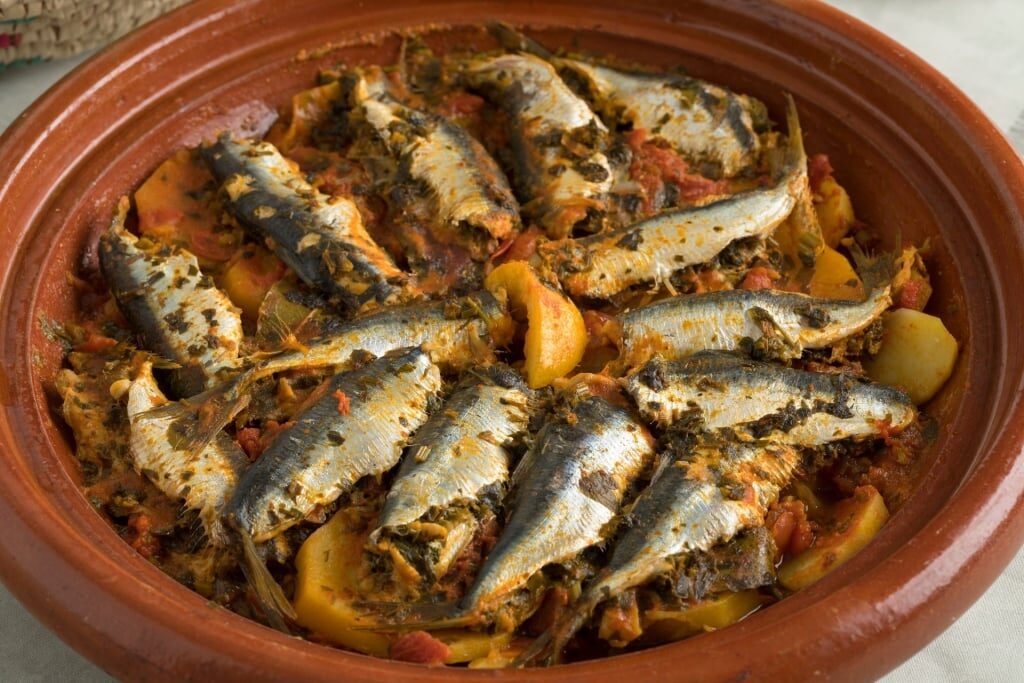
Sardines mchermel
The key to this popular Moroccan dish is a marinade of chermoula. This is a mix of cilantro, parsley, garlic, cumin, paprika, and preserved lemon in a base of olive oil.
Fresh sardines are stuffed with chermoula and covered in more before being baked in a tajine. The tajine will also hold a mix of vegetables, such as peppers, carrots, and olives.
The dish can be served hot or cold, as a main course or as part of a mezze spread. Of course, some fresh khobz is essential to make sure you can soak up all the rich juices.
Makouda
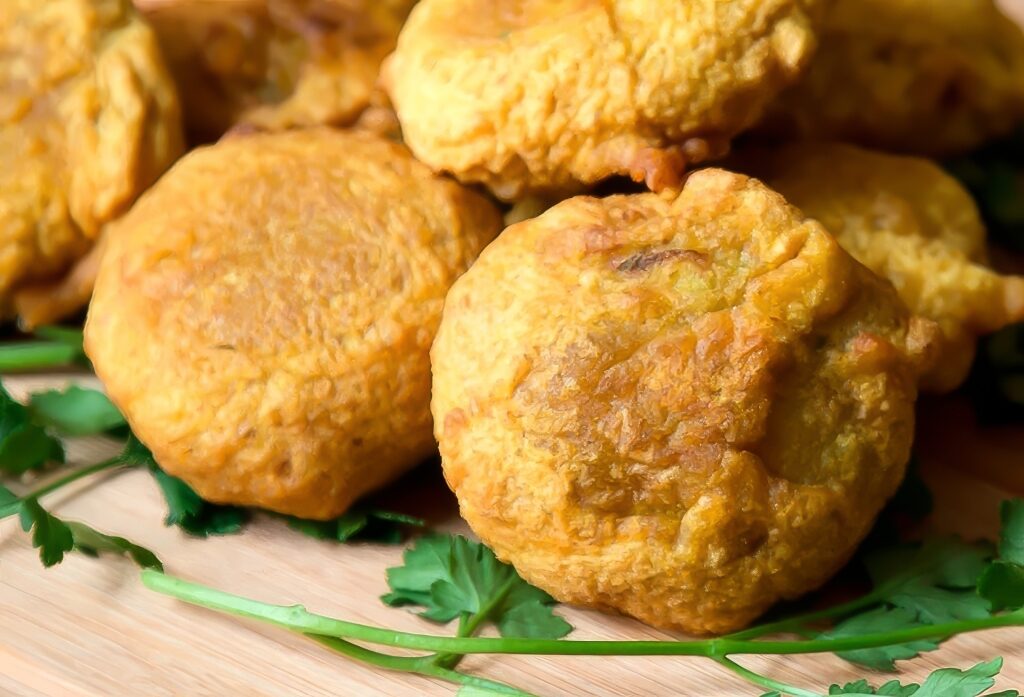
Makouda
These deep-fried potato balls are a popular street food in Morocco and throughout North Africa. Mashed potato is mixed with flour and herbs, then rolled into balls, patties, or croquettes, and fried until golden.
The result can be eaten as a snack, starter, or as a meal when served in bread. The makouda will be put into a baguette or wrapped in khobz and topped with various fillings.
Harissa is a popular filling, with its spiciness nicely complementing the carb-heavy sandwich. Other toppings range from tuna and olives to simple lettuce and tomato.
Merguez
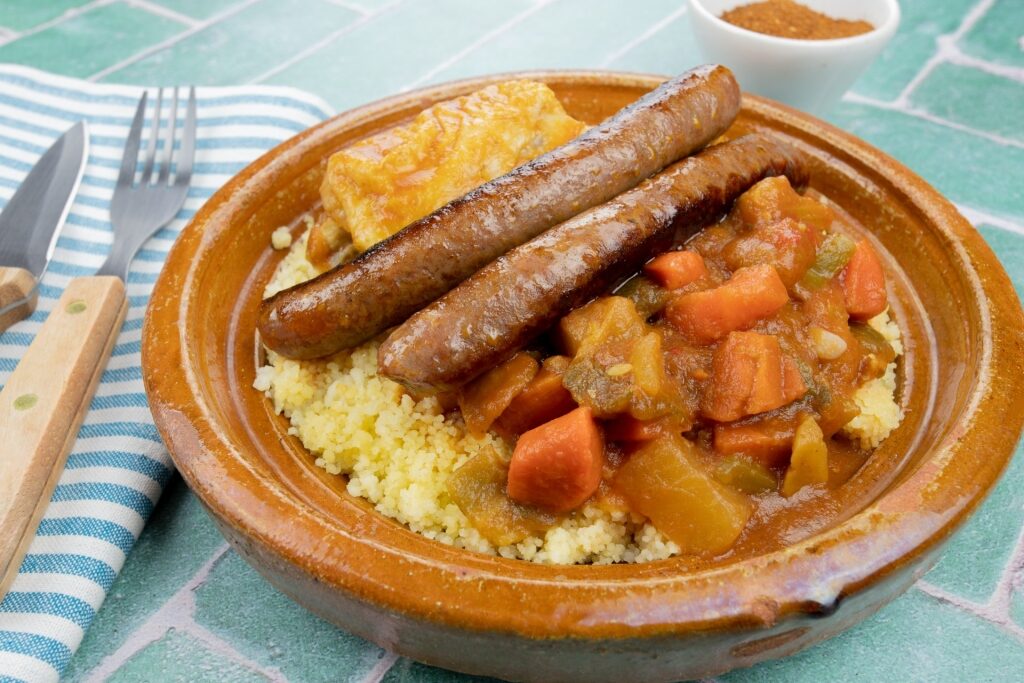
Merguez
This famous Moroccan sausage is made with lamb, or beef—but usually both—seasoned with harissa, paprika, cumin, fennel, or other spices. Grilled, it is best eaten with fresh khobz bread but you’ll find it served many other ways.
The sausage has a distinct red color from the spicy harissa and paprika. Its heat lends itself to its popular pairing with eggs or bread.
While often part of a mixed grill, you will also see merguez in tajines, couscous, and stews. Served either whole or sliced, it is also crumbled into other dishes as a tasty seasoning.
Preserved Lemon
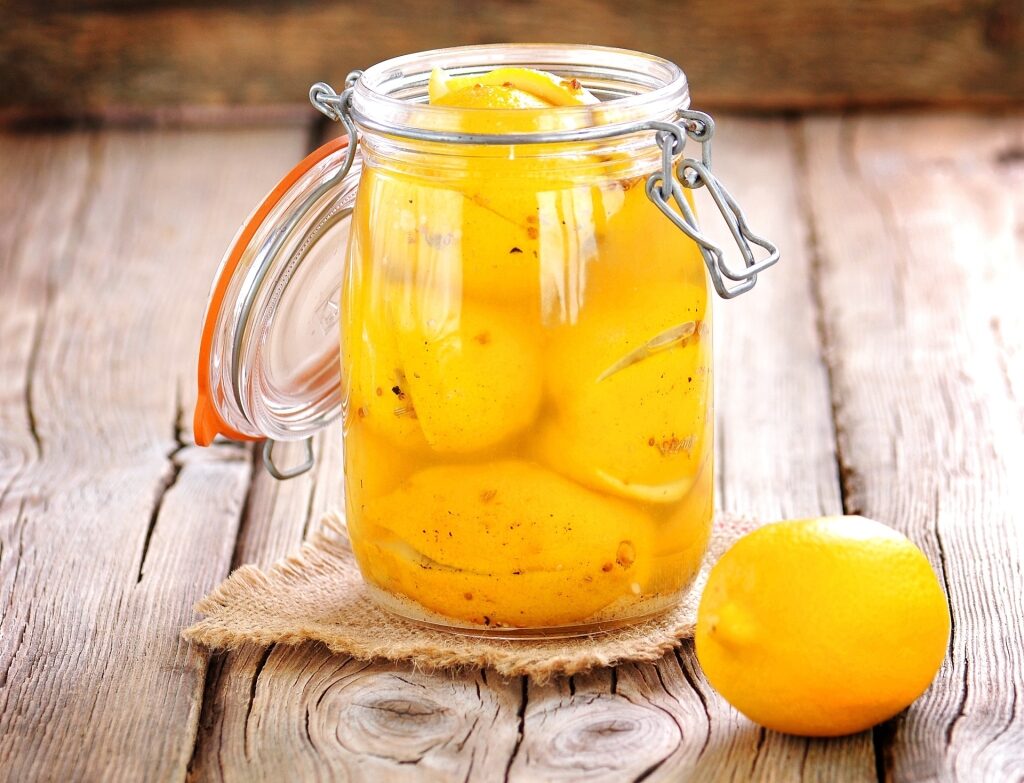
Preserved lemon
Not a dish but an ingredient, preserved lemon is central to many Moroccan dishes. It’s also known as “pickled lemon” or “country lemon” elsewhere in the world.
Whole, halved, or quartered lemons are salted, then pickled in lemon juice and salt. They are then allowed to stand for at least a month.
The process brings out extra intensity in the lemon, particularly in the rind. This makes them ideal in dishes such as slow-cooked tajines to add both brightness and flavor.
Mint Tea
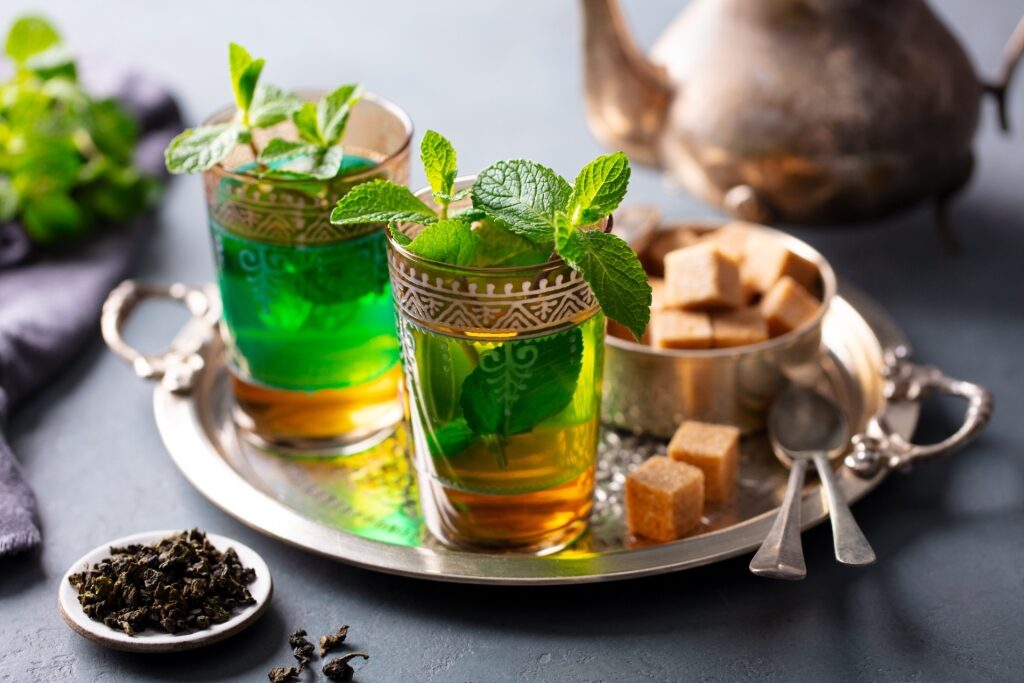
Mint tea
Mint tea is as much a symbol of Moroccan hospitality as it is a refreshing drink on a hot day. It’s traditionally made with fresh mint leaves and Chinese gunpowder green tea.
The hot tea is also usually made with sugar, although you can ask for it without in a restaurant. Be warned, it will taste very bitter without at least a touch of sugar.
Making the tea is a fascinating ritual, using a special pot called a “berrad”. It’s poured from a height to create a foam, with three glasses per person being the traditional protocol.
Read: What Is Casablanca Known For?
Chebakia
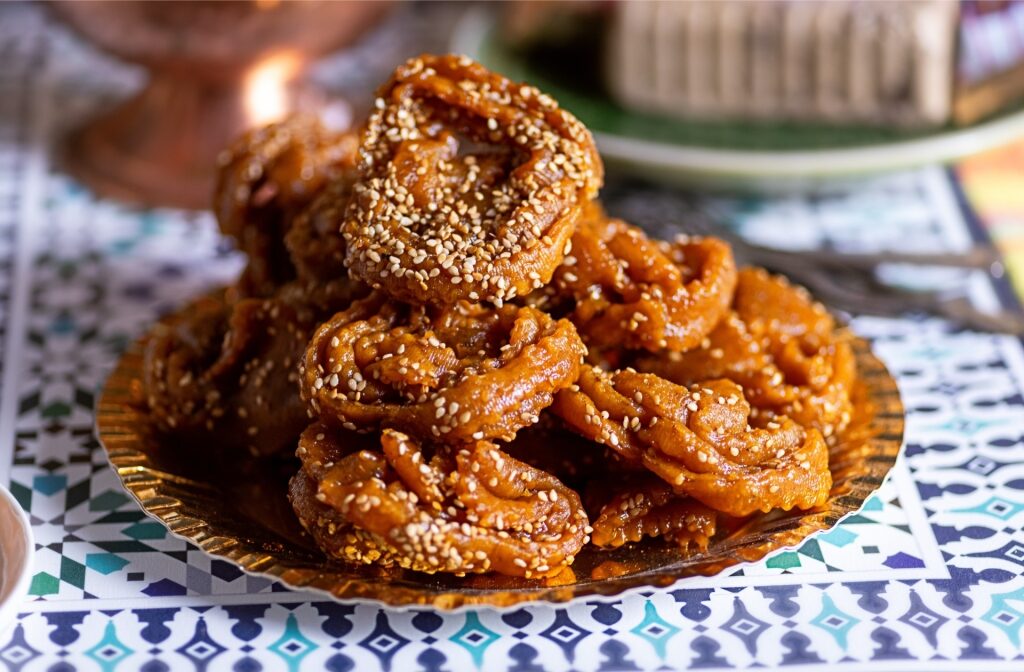
Chebakia
Chebakia is a flower-shaped cookie made from a dough with anise and sesame seeds, cinnamon, and saffron. This sweet pastry is another food traditionally associated with Ramadan, along with harira soup.
Folded into the shape of a rose, it is deep-fried until golden. Each is then soaked in honey and sprinkled with sesame seeds.
The result combines crispness, sweetness from the honey and flavor from the spices. After all that, the sesame seeds add yet another hit of deliciousness.
Kaab El Ghazal
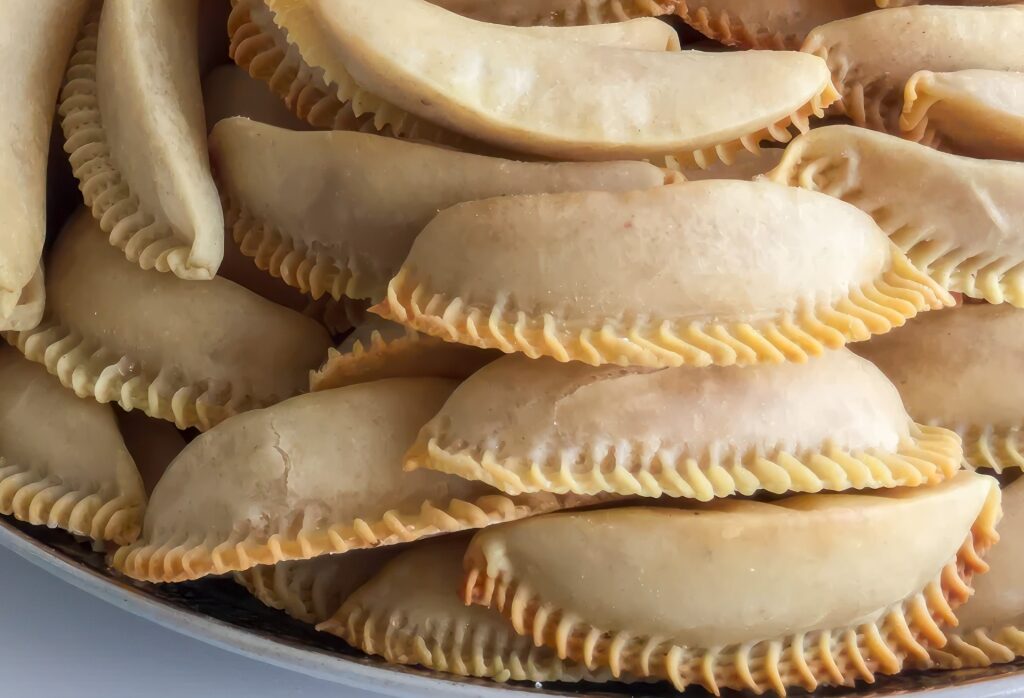
Kaab el ghazal
“Gazelle Horns” are croissant-shaped cookies now popular throughout the Arab world but originating in Morocco. A cinnamon-rich almond paste filling is wrapped in very thin, orange blossom-flavored pastry and topped with crushed almonds.
The curved shape, with a serrated edge, gives these delicious cookies their name. Often eaten with mint tea, they are commonly served during festivities.
For weddings, it is traditional for the bride’s family to prepare kaab el ghazal to show off their cooking skills. With recipes handed down through generations, they have a special place in Moroccan food culture.
Read: Best Beaches in Morocco
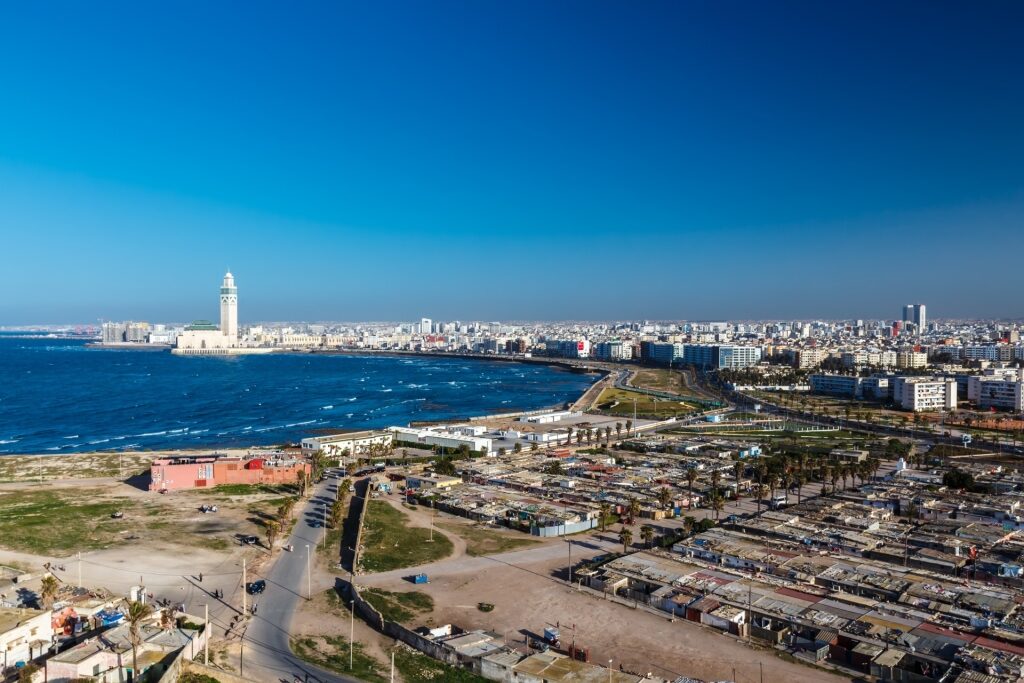
Casablanca
Are you tempted to try some of these delicious dishes? Browse Celebrity’s cruises to Morocco and plan your next adventure.
